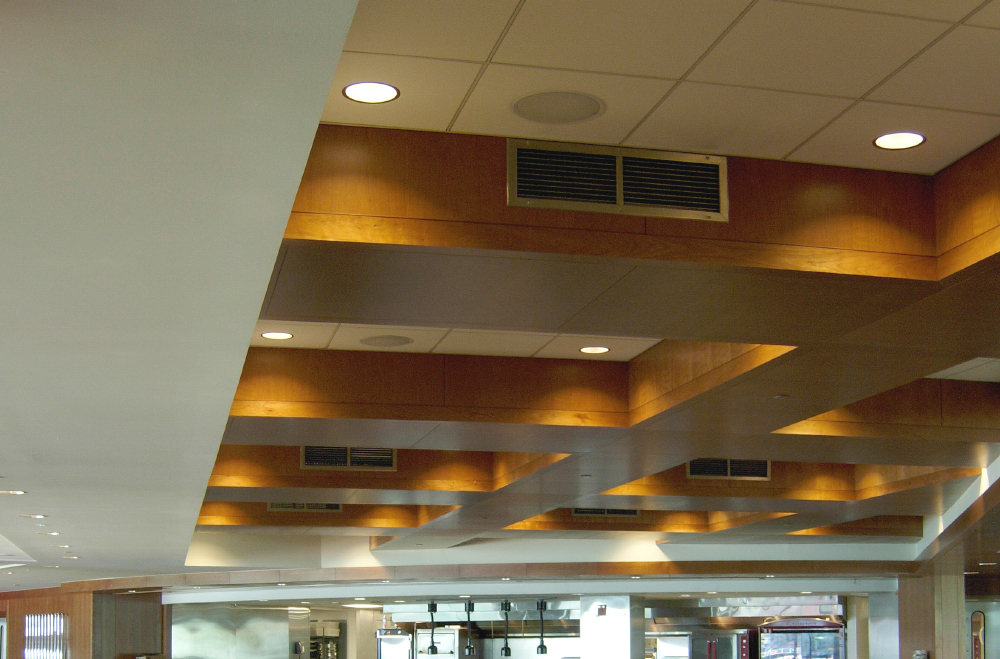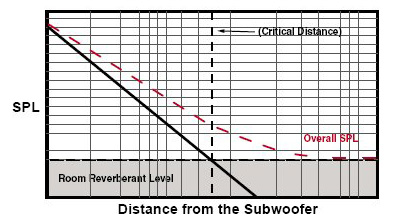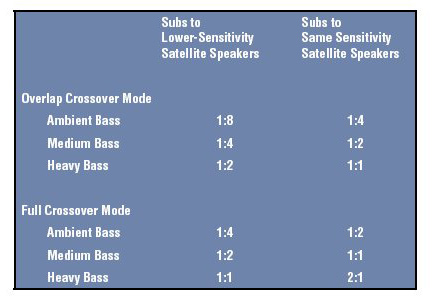
SPL And Frequency Response
Let’s delve a little more into the SPL requirements for subwoofers.
Typically the goal for subwoofers is to be somewhere between 2 and 10 dB louder than the main loudspeakers in the system.
Low- and medium-level music requires subs to be louder than the main loudspeakers because at low sound levels the human ear needs more bass for a perception of well-balanced sound.
Given the same music, higher levels of music can sound well balanced with less relative bass increase.
There are also some music types and applications, like dance music in upscale fashion retailers, that may require more than +10 dB of bass. Setting the ratio of subs to main speakers somewhere between +2 dB and +10 dB, as measured by a flat SPL meter, is usually a good starting point.
As for subwoofer frequency response, especially for business applications, you probably don’t want the subwoofer to go much below 40 Hz. Below that, you end up with bothersome rumble, which can build up in corners or at room-mode nodes (function of a room’s dimensions).
Rumble can annoy customers. They might not be conscious of it, but when they’re standing near the corner of the room, looking at clothing on a rack, low-frequency rumbling can make them uncomfortable enough to chase them out of the store.
If a customer says they don’t want subwoofers because they heard subs at the XYZ Store where the subs were bothersome, then there is a good chance that XYZ Store’s system installer made the mistake of putting in too much rumble below 40 Hz, or left in a mid-bass bump because of an overlap crossover, or used a passive crossover that doesn’t work correctly with the selected product mix.
The list of pitfalls goes on, but if it’s well-implemented by a skilled contractor, a business music system with subwoofers can sound absolutely wonderful!
Subwoofer Positioning
So how many will you use, where will you put them, how will you arrange them, and how will they relate to the mains?
Effect on SPL
Hanging a subwoofer in the middle of a room results in the lowest possible output from the subwoofer. Placing a subwoofer at the ceiling, wall or floor increases its output. Placing it within a few feet of a within 3 feet of a corner increases its output still more.
In these cases, there is both an increase in sensitivity (output per watt of input) and in maximum total SPL capability. This can help in getting as much sound as possible from a few subwoofers.
However, there is a potential pitfall in placing a subwoofer in a corner: You can wind up with uneven bass coverage in the room.
Achieving Even Coverage
In most installations, there are a lot more satellite loudspeakers than there are subwoofers.
Because there are often so few subwoofers (maybe only one), you can have a problem getting even coverage of the space.
People sitting or standing very close to the subwoofer are going to get blown away with lows while people who are father away might not be getting enough. How do you make the subwoofer coverage as even as possible?
As you move farther from the sub, the volume drops off, typically at 6 dB per doubling of distance.
Then, when you reach a certain distance, the subwoofer level stops dropping off at such a high rate.
This is called the critical distance, which is where the reverberant field within the room equals the direct sound from the subwoofer (Figure 2).
The critical distance depends on how reverberant the room is. As you get farther past critical distance, even though the level of the subwoofer doesn’t drop off nearly as quickly, the quality of the subwoofer sound might not be as good. Even though this may happen, it’s sometimes acceptable for subwoofers in business music applications.

One way to make the subwoofer coverage as even as possible is to use more than one. It’s a myth that all you ever need is one subwoofer. In many places, it’s a good idea to add a second subwoofer, or more.
Even if you don’t need additional subwoofers for volume reasons, you might want to consider them just for evenness of subwoofer coverage. If I absolutely have to use just one subwoofer, my personal preference is to sacrifice the sensitivity increase and place the subwoofer for most even coverage, as long as I can achieve the SPL goals.
Placing Two Subs
In systems with two subs, it is often best to place them asymmetrically within the room. In other words, if one sub is in the middle of a wall, try to avoid placing the second sub in the middle of the opposite wall.
Small-room acoustics can cause interactions between subwoofers to create places where the bass builds up and other places where the bass cancels out and disappears. The topic of room modes is a paper in itself, but for now it’s important to realize that, while there is not much you can do about room modes, you can minimize their effect with conscious subwoofer placement.
If you place both subs symmetrically (on opposite walls), they will excite the same room modes in the same way, making disparities worse. If you place the second sub in a different position, it will tend to excite the room modes in a different way, and this is usually better.
It’s also good to know that placing the sub in the corner, while it does excite room modes, usually results in fewer mode bumps as compared to mid-wall placement. My experience when using two subs has been that one goes in the corner and the other goes close to, but not in, the opposite corner, about 10 feet out along one of the walls.
Ratio Of Subs To Main Speakers
The subwoofer is usually required to put out more power than the main loudspeakers, so you might need more of them than you had guessed.
You’re not going to get much bass if you’re using 20 full-range loudspeakers at full power and only one or two subwoofers of the same power rating as the main loudspeakers.
Picture a 3-way home stereo loudspeaker. It has a 4-inch midrange driver and a tweeter. What size bass driver would you expect that one loudspeaker would need to keep up with the midrange and highs? You’re probably picturing an 8-inch driver, or even a 10- or 12-inch one. That’s to balance a single 4-inch midrange!
Now imagine a sound system with twenty 4-inch midrange drivers. You’re going to need several 8-inch subs, or a couple of 12-inch drivers, plus a lot more power handling capability. Note too that the full crossover mode requires more subwoofers because the subs are carrying the low-frequency load by themselves; but, again, it results in the best overall sound quality.
The ratios in Table 1 are no more than rough guidelines intended as starting points. The system designer needs to compute the SPL capability and determine that it will meet the user-expectations for the application.

Note that the chart assumes the loudspeakers are all installed in the ceiling away from wall and corner boundary surfaces (not getting the bass reinforcement from these boundary surfaces) and that if they are 70-volt/100-volt models, that both the mains and the subwoofers are tapped at their highest settings. You can scale up or down from there.
For example, if you’re tapping the main loudspeakers down two taps (usually this means they’re down 6 dB) then you can reduce the number of subwoofers from what is suggested. Also, if you’re placing the subwoofers in or near corners (around a 6 dB increase in sensitivity) you can reduce the number of subwoofers.
In addition, we’re assuming certain sensitivity and power handling capabilities that may need to be changed for your installation.
The subwoofer module in JBL’s DSD Distributed System Design software asks a bunch of these questions and then computes the proper number of subwoofers for the system.
Distributed Subwoofers
If you are using in-ceiling subwoofers, remember that the subwoofer coverage projected onto the listening plane only covers 120 degrees. If you’re concerned about having even coverage throughout the room, determine how many subwoofers you need based on approximate coverage of 120 degrees per subwoofer.
As noted above earlier, there are several computer programs that can help you with the design process. JBL’s free Distributed System Design utility does the polar-to-listening-plane conversions, computes how far apart to place the loudspeakers, computes how loud the system can get with music or speech (taking into account the overlap factors), tells you what the sound level variation will be throughout the room based on the layout pattern and density, calculates how much amplifier power the system needs, and calculates the number of subwoofers (if subs are being used).
While this particular program is only set up for JBL loudspeakers, there are utilities out there that handle other models.
But even the snazziest software won’t help until you determine your goals — and your client’s goals — for the system. That will tell you whether you’ve succeeded. Success is completely within your reach.
A well-designed, properly installed, wide-bandwidth, low-distortion business sound system can create an outstanding space that customers will enjoy and that will improve the business’ image and ultimately their sales.
Published with permission by JBL.
